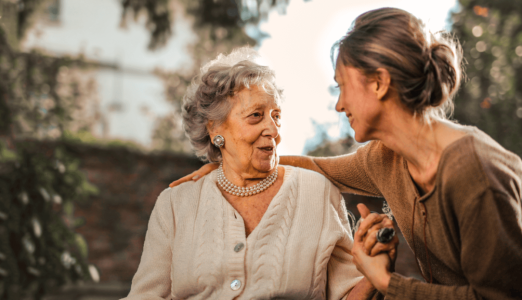Shocking truth about the use of force in aged care homes
- Replies 18
Cases of force used against the elderly have raised alarm bells in recent times, as we are left to question if our loved ones in aged care homes are truly safe, secure, and being treated with the respect they deserve.
Before entrusting our dearest to facilities that promise adequate care and safety, we must attempt to understand what could go wrong and how we can ensure that such incidents are appropriately addressed and prevented in the future.
Two heartbreaking stories involving elderly women with dementia have come to light, both taking place within aged care homes in Australia. The incidents resulted in their hospitalisation, with one of them now receiving end-of-life care at the age of 95.
These alarming events have led many to question the actions of the police and the use of force, protocols surrounding aged care home management, and whether any measures are in place to avert inappropriate actions.
Credit: 7NEWS Australia.
In the first incident, Clare Nowland, a 95-year-old grandmother who used a walking frame, was tasered by police at the Yallambee Lodge aged care facility in Cooma, NSW. Paramedics and police were summoned when they found her holding a steak knife.
Ms Nowland, advancing slowly with her walking frame, was struck with a taser and consequently fell, sustaining a head injury. Her family is now grief-stricken, and this tragic case is being investigated by relevant law enforcement agencies.
You can find more information about this story in this article.
The second incident involves Rachel Grahame, who was forcibly handcuffed by the police in 2020 after she took a lanyard and electronic device from a desk at St Basil's aged care home in Sydney. In the footage, she can be heard crying for help and questioning the officers during the incident.
Her family filed a lawsuit against the NSW police, accusing them of assault, battery, and false imprisonment. Eventually, they received compensation.
According to Ms Grahame's daughter, Emma, who spoke to a news source, she believes that the police should not have been called in the first place.

What are the rules surrounding the use of force in aged care homes?
The horrific situations mentioned above beg a closer look at the policies and guidelines surrounding the use of force in aged care homes. The NSW Law Enforcement (Powers and Responsibilities) Act 2002, for instance, states that an officer may use 'such force as is reasonably necessary' for arrest or preventing escape.
However, these rules become murky when applied to cases involving vulnerable individuals like those residing in aged care homes, turning our focus to the federal government's Aged Care Quality Standards.
These standards mandate that care providers have systems in place offering protection and safeguards around the delivery of care and services.
The Serious Incident Response Scheme (SIRS) comes into play following incidents and near misses, aiming to support affected parties and minimise the risk of recurrence. It categorises unreasonable use of force as actions that range from unwarranted physical force to violent physical assault.
To better support people with dementia, the government has also funded Dementia Training Australia to deliver the Dementia Training Program, with the revised Certificate III in Individual Support (Ageing), including mandatory components for supporting dementia patients.
Furthermore, the Older Persons Advocacy Network (OPAN) acknowledges the need for proper training and skills to support elderly individuals with dementia, pointing to 'huge skills gaps' in aged care staff training.

As we entrust our vulnerable loved ones to aged care homes, it becomes imperative to question the level of safety and protection they offer. What are your thoughts on this topic? Have you or anyone you know been contemplating the idea of entering aged care facilities in the near future?
In your opinion, what sort of training and support should be provided to care home staff to enable them to effectively handle challenging situations involving residents with dementia without resorting to excessive force? We would love to hear your thoughts on this matter, so please feel free to share your insights in the comments section below!
Before entrusting our dearest to facilities that promise adequate care and safety, we must attempt to understand what could go wrong and how we can ensure that such incidents are appropriately addressed and prevented in the future.
Two heartbreaking stories involving elderly women with dementia have come to light, both taking place within aged care homes in Australia. The incidents resulted in their hospitalisation, with one of them now receiving end-of-life care at the age of 95.
These alarming events have led many to question the actions of the police and the use of force, protocols surrounding aged care home management, and whether any measures are in place to avert inappropriate actions.
Credit: 7NEWS Australia.
In the first incident, Clare Nowland, a 95-year-old grandmother who used a walking frame, was tasered by police at the Yallambee Lodge aged care facility in Cooma, NSW. Paramedics and police were summoned when they found her holding a steak knife.
Ms Nowland, advancing slowly with her walking frame, was struck with a taser and consequently fell, sustaining a head injury. Her family is now grief-stricken, and this tragic case is being investigated by relevant law enforcement agencies.
You can find more information about this story in this article.
The second incident involves Rachel Grahame, who was forcibly handcuffed by the police in 2020 after she took a lanyard and electronic device from a desk at St Basil's aged care home in Sydney. In the footage, she can be heard crying for help and questioning the officers during the incident.
Her family filed a lawsuit against the NSW police, accusing them of assault, battery, and false imprisonment. Eventually, they received compensation.
According to Ms Grahame's daughter, Emma, who spoke to a news source, she believes that the police should not have been called in the first place.

Are there rules or restrictions for police and staff in care homes for these situations? Credit: Pexels/Andrea Piacquadio.
What are the rules surrounding the use of force in aged care homes?
The horrific situations mentioned above beg a closer look at the policies and guidelines surrounding the use of force in aged care homes. The NSW Law Enforcement (Powers and Responsibilities) Act 2002, for instance, states that an officer may use 'such force as is reasonably necessary' for arrest or preventing escape.
However, these rules become murky when applied to cases involving vulnerable individuals like those residing in aged care homes, turning our focus to the federal government's Aged Care Quality Standards.
These standards mandate that care providers have systems in place offering protection and safeguards around the delivery of care and services.
The Serious Incident Response Scheme (SIRS) comes into play following incidents and near misses, aiming to support affected parties and minimise the risk of recurrence. It categorises unreasonable use of force as actions that range from unwarranted physical force to violent physical assault.
To better support people with dementia, the government has also funded Dementia Training Australia to deliver the Dementia Training Program, with the revised Certificate III in Individual Support (Ageing), including mandatory components for supporting dementia patients.
Furthermore, the Older Persons Advocacy Network (OPAN) acknowledges the need for proper training and skills to support elderly individuals with dementia, pointing to 'huge skills gaps' in aged care staff training.
Key Takeaways
- Two separate incidents involving elderly women with dementia in aged care homes have raised questions about the actions of police and the use of force.
- The NSW Law Enforcement (Powers and Responsibilities) Act 2002 states that a police officer 'may use such force as is reasonably necessary' under certain conditions, but both cases involved frail women with dementia in aged care facilities.
- The federal government's Aged Care Quality Standards require aged care service providers to have systems in place to provide protections and safeguards around the delivery of care and services.
As we entrust our vulnerable loved ones to aged care homes, it becomes imperative to question the level of safety and protection they offer. What are your thoughts on this topic? Have you or anyone you know been contemplating the idea of entering aged care facilities in the near future?
In your opinion, what sort of training and support should be provided to care home staff to enable them to effectively handle challenging situations involving residents with dementia without resorting to excessive force? We would love to hear your thoughts on this matter, so please feel free to share your insights in the comments section below!







